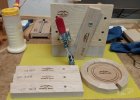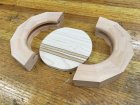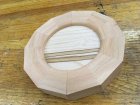Hi. First real post. Be nice.
I've been turning a while (years) but never did any segmenting. One of my quarantine objectives was to learn it. So I built a wedgie sled and got started. Now I'm hooked on another thing!
Couple examples:


Anyhow - I've not been satisfied with a solid base so I experimented with a segmented base. Liked the results - but they are CRACKING! Research tells me this isn't unusual (seasonal movement).
I'd like to get some input on what (if anything) works. I've been toying with a couple ideas and would appreciate your input.
Thanks in advance!
I've been turning a while (years) but never did any segmenting. One of my quarantine objectives was to learn it. So I built a wedgie sled and got started. Now I'm hooked on another thing!
Couple examples:


Anyhow - I've not been satisfied with a solid base so I experimented with a segmented base. Liked the results - but they are CRACKING! Research tells me this isn't unusual (seasonal movement).
I'd like to get some input on what (if anything) works. I've been toying with a couple ideas and would appreciate your input.
Thanks in advance!





